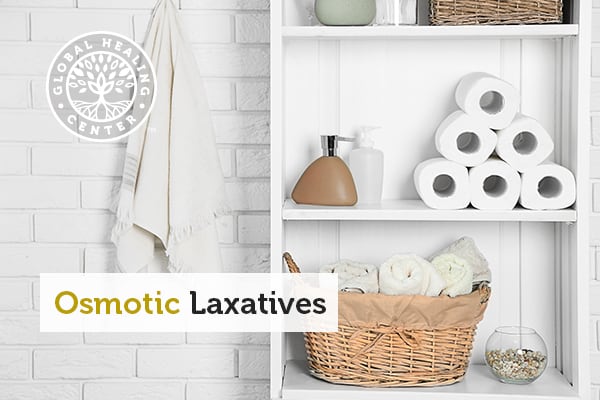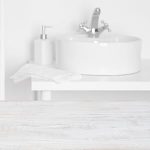
Occasional constipation happens. And it happens to a lot of people, a lot of the time. According to the American College of Gastroenterology, every year, over 2.5 million people visit their doctor for constipation.[1] If you’re one of them, you may want to know how to deal with this uncomfortable situation.
Eating a nutritious diet, staying hydrated, and living a healthy lifestyle should be enough to keep things moving. But when that isn’t quite enough, many people look for something that can help them go. People in the United States spend over one billion dollars on laxatives every year.[2]
Laxatives are available without a prescription, frequently advertised on TV, and often presented like a trusted and reliable old friend. But laxatives are not the best way to relieve your bowels — whether you have occasional or chronic constipation.
Some laxatives are harsh and make you feel uncomfortable. They can also present other more serious side effects, especially with long-term use. In this article, we’re going to look at osmotic laxatives and explain why you should think twice before using them.
What Are Osmotic Laxatives & How Do They Work
Osmotic laxatives are a specific type of laxative (other kinds include stimulant laxatives, stool softeners like mineral oil, and bulk-forming laxatives like fiber supplements). Osmotic laxatives work through “osmosis” — which is to say that they draw water into the intestinal lumen and colon.
Imagine the intestines as a tube. The lumen is the space inside. In the case of occasional constipation, the lumen isn’t empty; it’s blocked up with fecal matter. Almost like a less-invasive enema, the extra water loosens fecal matter so you can expel it from the body in a loose bowel movement.[3] However, because they draw water into the colon, it can cause you to become dehydrated.
Types of Osmotic Laxatives
There are a few different chemical compounds categorized as osmotic laxatives. You’ll find them under several brand names and forms, including liquids, powders, and chewable tablets.
Saline Laxatives
Saline laxatives may include one or more of the following ingredients: magnesium hydroxide, magnesium sulfate, magnesium citrate, sodium phosphate, and sodium sulfate. Some saline laxatives are available over the counter. Your doctor may prescribe them before surgery.
Poorly Absorbed Sugars
Some sugars — lactulose, sorbitol, mannitol, lactose, and sugar alcohols — get fermented by your gut microbiota, rather than digested. This fermentation produces fatty acids that promote the flow of water into the colon. The fermentation produces gas, which can cause uncomfortable bloating and cramping.
Polyethylene Glycol AKA PEG 33500
Polyethylene glycol, also known as macrogol, is a polymer that’s not absorbed in the digestive tract. It’s often used to prepare a person for surgery by emptying the intestinal tract.[4]
Milk of Magnesia Hydroxide
Magnesium hydroxide, also known as milk of magnesia, is a common osmotic laxative.[5] The formula often contains harsh chemicals like sodium hypochlorite (bleach) and other substances. Magnesium, however, can be an excellent laxative when used in an oxygen-based colon cleanser — see below.
Are Osmotic Laxatives Healthy For Your Digestive System?
Osmotic laxatives are available over the counter, and their use is common. But, that doesn’t mean they don’t have side effects or that they’re ideal. Osmotic laxatives can be uncomfortable and dehydrating. They can also cause gut imbalances, among other issues.[6]
Let’s take a closer look at the side effects of osmotic laxatives and why they aren’t the best way to relieve constipation.
Long Wait Time
Osmotic laxatives can be very slow-acting. Although some people find relief in hours, it’s not uncommon for them to take days to act. Chances are if you think you need a laxative, you want it to work a lot faster than that. And, while playing the waiting game, many people experience uncomfortable gas, bloating, and cramping.[5]
Usually Harsh & Uncomfortable
Most people who use osmotic laxatives don’t describe it as a comfortable experience. Conversely, painful gas and bloating are more common than not. Many people also cite a feeling of weakness and lethargy.[5]
Imbalances the Body
Osmotic laxatives rob Peter to pay Paul: the water they draw into the colon can result in some other area of your body going without. One of the most common side effects of osmotic laxatives is electrolyte and fluid imbalances in the body.[5, 7]
Dry skin, fatigue, increased heart rate, and stress on the kidneys are common manifestations of dehydration.[8] What’s more, long-term use of osmotic laxatives can harm your gut microbiota.[9]
Laxative Dependency
Using osmotic laxatives, especially long-term or extended use, can result in a whole new issue: dependency on laxatives to have any bowel movement.
Even when a healthcare professional recommends osmotic laxatives, it’s limited to short-term use. Frequent use can lead to a “cathartic colon” — a change in the structure and function of the colon resulting from laxative use.[10]
What Is the Best Remedy for Occasional Constipation?
Dealing with occasional constipation is a situation that poses two issues. First, what are you going to do to achieve immediate relief? Second, what are you going to do to help reduce the likelihood of it coming back?
I recommend Oxy-Powder® which uses ozonated magnesium oxides to release oxygen into the colon. This action gently but thoroughly flushes and cleanses the entire digestive tract and relieves occasional constipation. Oxy-Powder works overnight so that you will wake up able to empty your bowel without having to wait days.
In my experience, oxygen-based intestinal cleansers are the smart approach to relieve occasional constipation. They’re gentle, fast, affordable, and natural.
Maintaining Long-Term Regularity
Occasional constipation happens. But if it’s becoming more than occasional, it’s time to take a step back, survey the entire situation, and ask yourself what you can do to prevent the issue before it starts. Here are some suggestions.
Stay Hydrated
Water is one of the most important things you need to sustain life, health, and wellness.
Without adequate water, bowel movement regularity is impossible. Whatever your body weight is in pounds, drink half that amount in ounces per day to stay hydrated.
Follow a Healthy Diet
Make raw, organic fruits, vegetables, gluten-free whole grains, and legumes the foundation of your diet. Not only are they nutritious and pure, but they’re also a good source of natural fiber and enzymes. Enzymes support digestion and fiber acts like a scrub brush inside your intestines. It also helps to feed the good microbes that live in the gut. Try to get 50 grams of fiber every day to keep your digestive system happy and healthy.
Take Care of Your Liver
Bile is a digestive fluid that’s made by the liver. Having enough bile maintains digestive health and regularity. If you bog down your liver with dietary or other toxins, it can become congested, slowing down bile production.
Minimize your intake of alcohol and unhealthy fats. You can also eat a diet that includes cholagogues — foods that help stimulate bile flow. A few include turmeric, celery, and beets. Last, but not least, perform a liver cleanse a few times a year to encourage normal liver health.[11]
Live a Healthy Life
Stay hydrated, eat healthily, and get enough sleep. These should be the heart of your efforts in promoting digestive health.
Exercise daily, even if it's just stretching or walking. If you can do high-intensity physical activity, even better. How you are on the outside will set the pace for your insides. Make daily activity a regular part of your life.
Cleanse Your Gut
One of the best, health-promoting tactics is to cleanse your colon and intestinal tract. We’re exposed daily to environmental toxins in the air, food, and water. It has a dragging effect on the digestive system, liver, kidneys, and more. Regularly cleansing these systems can help promote digestive — and overall — health.
Doing this also enables you to balance your gut flora. Your microbiota influences every aspect of your health and especially digestion. If your gut is weak, don't be surprised if your bowel movements are equally puny. Make sure that fermented foods are part of your diet, and take a high-quality probiotic supplement, ideally one with multiple strains and 75 billion CFUs.
If you are ready to truly reset your health and improve digestion, try a 30-day gut health cleanse. Our Gut Health Kit™ provides everything you need to follow in order to reset and balance your gut.
Points to Remember
Osmotic laxatives are a type of laxative that produce a bowel movement by drawing water into the colon. The water helps to dislodge compacted waste. Although their use is common, it’s not especially pleasant. Uncomfortable nausea, gas, bloating, and cramping are among the most common side effects of osmotic laxatives.
If you can avoid the need for laxatives in the first place, you’ll be happier and better off. Follow a healthy diet, stay hydrated, get some exercise every day, take care of your gut, and make cleansing your colon and liver part of your routine maintenance.
If you’ve done everything you can and occasional constipation is becoming more frequent, start a conversation with your healthcare provider. There could be another contributing factor that requires a different approach.
References (11)
- Wald A. Constipation and Defecation Problems. University of Wisconsin School of Medicine and Public Health, Madison, WI – Published June 2004. Updated January 2010. Updated March 2016.
- Laxatives OTC revenue in the United States from 2011 to 2017. Statista. Accessed March 25, 2019.
- Treatments for Constipation: A Review of Systematic Reviews [Internet]. Ottawa (ON): Canadian Agency for Drugs and Technologies in Health. CADTH Rapid Response Reports. 2014 Nov.
- Siegel J, Di Palma J. Medical Treatment of Constipation. Clin Colon Rectal Surg. 2005 May; 18(2): 76–80.
- Koppen I, et al. Management of Functional Constipation in Children: Therapy in Practice. Paediatr Drugs. 2015; 17: 349–360.
- Schuster B. Constipation in older adults. Can Fam Physician. 2015 Feb; 61(2): 152–158.
- Longo SA, et al. Gastrointestinal conditions during pregnancy. Clin Colon Rectal Surg. 2010;23(2):80–9.
- Portalatin M, Winstead N. Medical Management of Constipation. Clin Colon Rectal Surg. 2012 Mar; 25(1): 12–19.
- Tropini C, et al. Transient Osmotic Perturbation Causes Long-Term Alteration to the Gut Microbiota. VOLUME 173, ISSUE 7, P1742-1754.E17, JUNE 14, 2018.
- Joo JS, et al. Alterations in colonic anatomy induced by chronic stimulant laxatives: the cathartic colon revisited. J Clin Gastroenterol. 1998;26(4):283–6.
- Mosinska P, et al. Inhibition of ileal bile acid transporter: An emerging therapeutic strategy for chronic idiopathic constipation. World J Gastroenterol. 2015 Jun 28; 21(24): 7436–7442.
†Results may vary. Information and statements made are for education purposes and are not intended to replace the advice of your doctor. If you have a severe medical condition or health concern, see your physician.







